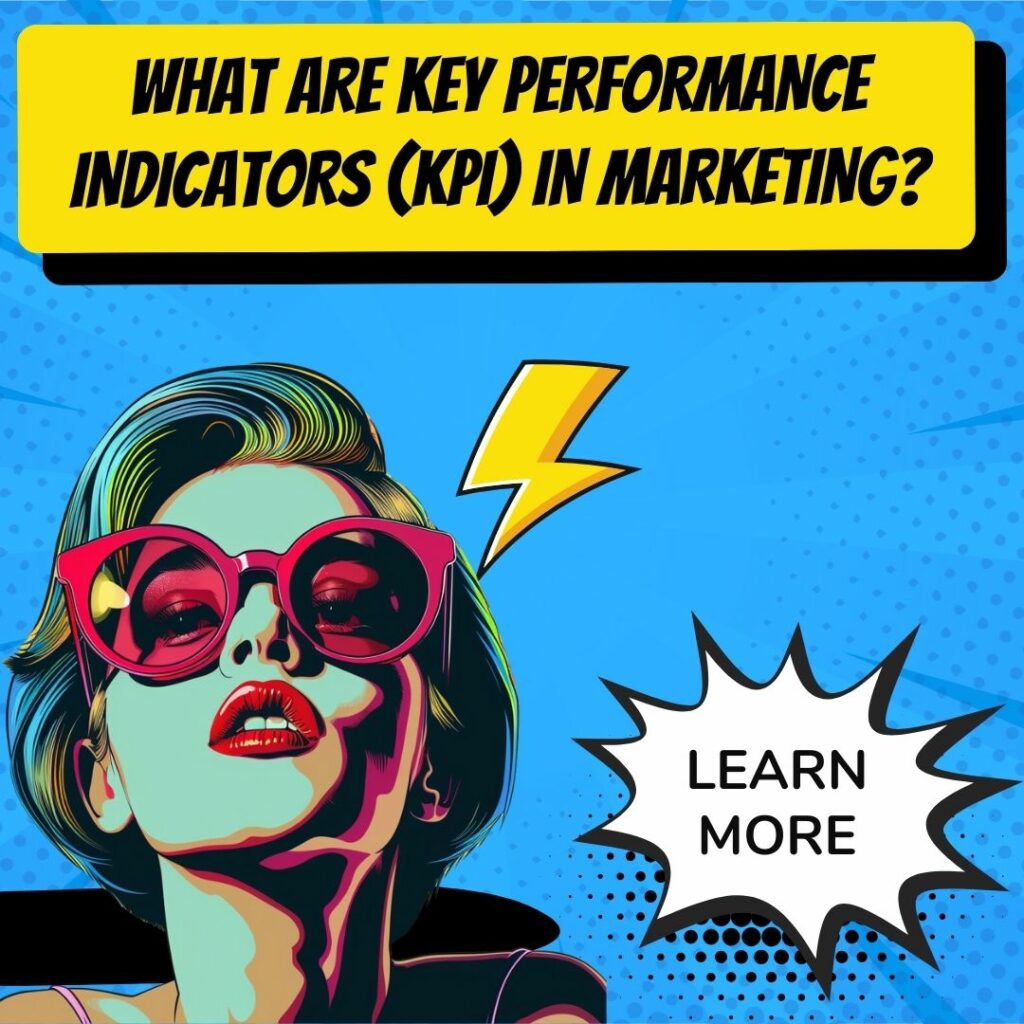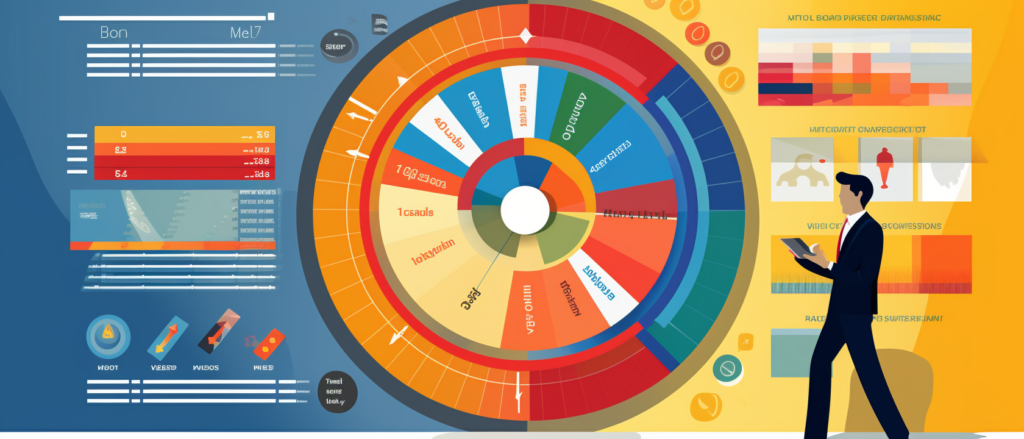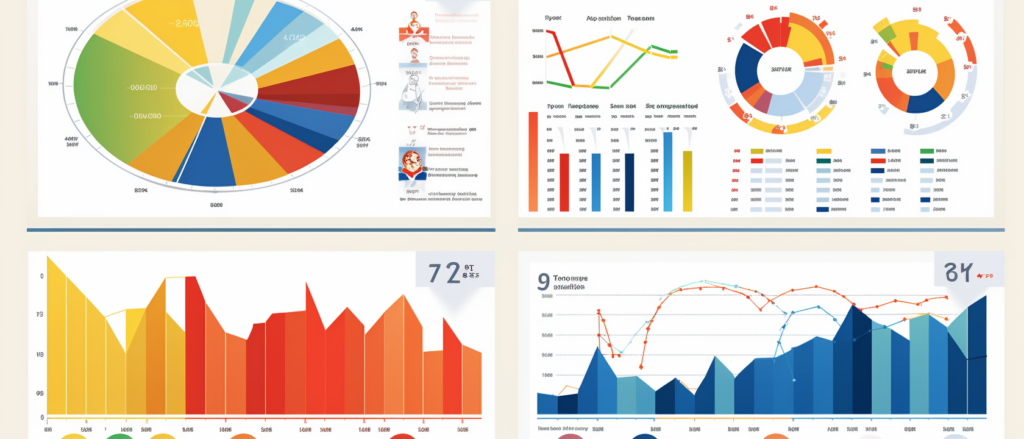Key Takeaways
✅ Defining KPIs: Dive into what Key Performance Indicators (KPIs) really mean in the marketing world. They’re not just numbers; they’re snapshots of success, showing you if your marketing moves are hitting the mark or if it’s time for a strategic shuffle.
✅ Types of KPIs: From knowing how many new faces pop up on your site to understanding the real deal behind every dollar spent, we’ll walk you through the KPIs that keep your marketing engine revving.
✅ Aligning KPIs: Get the lowdown on how to make sure your KPIs aren’t just impressive stats but are actually working hard to meet your big-picture goals. It’s about making sure your compass is pointing toward true north in the marketing world.

Introduction
Ever find yourself wondering whether your marketing efforts are like hidden treasure, full of potential, just waiting to be tapped into? Or do you sometimes feel as though you’re adrift in the vast sea of data, unsure of what to steer towards? Here’s where the compass of Key Performance Indicators (KPIs) for Marketing comes in.
In a world where everyone’s fighting to get noticed, understanding and tracking the right KPIs can shine a beacon on your successes and help you navigate away from icebergs. This article isn’t just about numbers; it’s about stories – tales of campaigns that soared and why they reached the stars, and cautionary fables of missed opportunities. Using the magic of KPIs, we’ll help you chart the path to not only survive in the fierce ocean of marketing but to thrive.
Top Statistics
| Statistics | Insight |
|---|---|
| Global Digital Ad Spend: Projected to reach $456 billion in 2021, up from $378 billion in 2020. (Source: eMarketer[1]) | The increasing digital footprint and spending trends are clear indicators for companies to allocate more budget to online advertising. |
| Email Marketing ROI: Generates an average of $42 for every dollar spent, one of the highest. (Source: DMA UK[2]) | This statistic reaffirms email as a powerhouse for effective customer communication and cost efficiency. |
| Engagement Rate on Social Media: Instagram leads at 1.9%, outperforming Facebook and Twitter. (Source: Hootsuite[3]) | Engagement rates can steer businesses toward the most responsive platforms for their social media strategies. |
| Video Content Traffic: 82% of internet traffic will come from video streams and downloads by 2022. (Source: Cisco[4]) | The compelling rise in video content highlights its necessity in content marketing strategies. Don’t you think it’s time to press ‘record’? |
| Mobile Web Traffic: Accounts for about half of the web traffic globally. (Source: Statista[5]) | Mobile’s share of web traffic emphasizes the importance of mobile-friendly websites. Is your website optimized for those on the go? |
Setting SMART Goals for Your Marketing Campaigns
Have you ever set a goal that was so broad you didn’t even know where to start? Well, that’s where SMART goals come in to save the day. Imagine you own a small bakery. Instead of saying, “I want more customers,” you get specific. You decide, “I aim to increase cake sales by 20% in the next 3 months.” Now, that’s a goal you can bite into! It’s specific with cake sales, measurable with the 20% increase, achievable if you’ve got the right oven for it, relevant to your business, and time-bound with a 3-month frame. Can you see how each of those parts help you focus your marketing efforts like a laser?
Essential KPIs for Marketing
Imagine walking into a treasure-filled cave, that’s what diving into marketing KPIs is like. You wonder, which gems are worth pocketing? For starters, look at your website traffic – it tells you how many folks are dropping by your online home. Not just numbers, but who, when, and why. Are they sticking around like a loyal friend or vanishing like a puff of smoke? That’s where bounce rate comes into play. Then, you’ve got conversions – think of them like welcoming a guest into your store. Are they just browsing, or are they actually buying? Lastly, there’s the buzz around your brand. Is your brand sparking conversations, inspiring stories, and turning heads? That’s engagement and brand awareness. These KPIs are like the cardinal points on a compass, guiding you through the marketing landscape.
Choosing the Right KPIs
Selecting the best KPIs for your business is like picking the right path on a hike. You don’t need to follow every trail, just the ones taking you to the top. Things to think about: Are you more concerned with getting new customers or making sure the current ones stick around? This choice will determine whether you should emphasize acquisition or retention metrics. And keep it flexible – what works for a cozy café might not suit a fast-paced tech startup. Regularly review your chosen KPIs to ensure they’re still taking you where you need to go, because what’s the worth of climbing a ladder that’s leaning against the wrong wall?
Data Collection and Analysis in Marketing
Now, let’s get down to the nitty-gritty of data collection. Treat Google Analytics like your personal sherpa through the mountains of data. Then delve into your social platforms to see who’s loving your posts. And don’t overlook your Customer Relationship Management (CRM) tool – it can whisper all sorts of secrets about customer behaviors. What you’re after are trends over time, patterns that turn the jumble of numbers into a clear story. And present them well—because data visualization with charts and graphs can turn a boring report into an insightful story that even the most data-phobic teammate can love.
Communicating KPI Results Within Your Company
Once you’ve gathered your KPI data, think of yourself as the town crier. It’s your job to keep everyone from the marketing team to the board members in the know. But don’t just toss a bunch of numbers at them. Weave those numbers into relatable stories. A sharp spike in web traffic after your latest campaign? That’s a victory march. A drop in customer satisfaction scores? That’s a twist in the plot, a dragon to slay with better service. Keep the communication clear and frequent, and turn those KPI insights into actionable strategies – because what’s more exciting than a story where we all get to be the heroes in the end?
Embracing Continuous Improvement Through KPIs
Treating KPIs as your guide means you’re always on a quest for improvement. These indicators point out what’s working – maybe that new packaging has people raving, or a revamped website layout is keeping visitors interested longer. They also highlight where you went off-track, giving you real-life feedback that’s as valuable as gold. Staying adaptive and responsive to what KPIs are telling you is like having a secret weapon. It means you’re not just throwing darts in the dark, hoping to hit a bullseye—you’ve got a laser sight, and you’re learning how to aim better with every shot.
AI Marketing Engineers Recommendation
Recommendation 1: Align Your KPIs with Customer Journey Mapping: Dive into your customer’s shoes—how do they discover your product? What makes them click that “buy” button? Mapping out each step of your customer’s journey is like following a treasure map. By aligning your KPIs with the customer journey, you measure what truly matters. Track metrics like click-through rates (CTR) on early-stage content or conversion rates on product pages. Make sure each KPI reflects a specific leg of the journey. This way, you can spot exactly where you’re winning customers over—or where you’re losing them. Data speaks volumes, doesn’t it?
Recommendation 2: Embrace Engagement Metrics for Content Performance: Let’s chat about content. It’s king, right? But how do you know if your content wears the crown or if it’s a pauper in disguise? By tapping into engagement metrics. Track how folks interact with your blogs, videos, podcasts, or infographics. Likes, shares, comments, and average time spent—are your stories gripping enough? With the rise of content as a central marketing strategy, your engagement metrics will reveal the narrative behind what content resonates with your audience. Isn’t it smarter to follow what your audience loves?
Recommendation 3: Leverage Predictive Analysis Tools for Forecasting KPI Performance: Have you ever wished you could predict the future? Well, guess what? With predictive analytics tools, you kinda can—at least when it comes to marketing. These tools use past data to forecast future outcomes. Imagine knowing which marketing actions might lead to the best performance down the line. By employing tools like Google Analytics Predictive Metrics or IBM Watson, you’ll turn historical data into forward-thinking strategy, making sure your KPIs aren’t just numbers but a crystal ball. Doesn’t that sound like an edge you’d want to have?
Conclusion
So, where do we go from here? Think of Key Performance Indicators (KPIs) as your marketing campaign’s compass, guiding you through the choppy waters of the business world. From setting goals that make sense (you remember SMART, right?) to picking just the right mix of metrics that speak to your unique business heartbeat, KPIs are more than just numbers on a screen—they’re the pulse of your marketing efforts.
Have you noticed how much sense it makes to measure how many folks drop by your website, or ponder the reasons they might leave without saying hi (or making a purchase)? Those are the insights that can only come from a clever use of KPIs. And let’s not forget about engaging with your customers. Seeing those engagement rates climb feels like a standing ovation from your audience, doesn’t it?
Imagine the power of knowing exactly what works and what needs tweaking. By choosing the right KPIs, gathering the data, and then sharing the story that data tells, everyone from the corner office to the front lines gets to share in a collective aha-moment. When your team rallies around clear goals and celebrates those wins, that’s not just good marketing—that’s great team spirit.
Bottom line? If you’re not using KPIs yet, you’re navigating without a map. Start small if that feels right, choose a KPI that speaks to you, and just start tracking. And always keep one ear to the ground for new ways to sharpen your insight with them. Because in marketing, as in life, continuous improvement is the name of the game. Ready to set sail toward success? Your KPIs are waiting to chart the course..
FAQs
Question 1: What are Key Performance Indicators (KPIs)?
Answer: Key Performance Indicators, or KPIs for short, are the breadcrumbs that guide marketers through the forest of data out there. They’re like little signs that tell us if we’re on the right path to meeting our business goals. Whether we’re looking at sales numbers, how many people visited our website, or how often customers come back for more, KPIs are all about keeping score of how we’re doing.
Question 2: Why are KPIs important in marketing?
Answer: I like to think of KPIs as a pair of glasses for a marketer. Without them, everything looks a bit blurry. But put them on, and suddenly you can see what’s working and what’s not. They help us make smart decisions instead of just guessing and make it easier to explain to the big bosses why we spend money on certain campaigns.
Question 3: How do I choose the right KPIs for my marketing strategy?
Answer: Choosing KPIs can be a bit like a treasure hunt. You start with your map—the goals of your business and marketing plan. Then, you look for the X’s on the map—the specific, measurable, achievable, relevant, and time-bound targets that’ll tell you if you’re getting closer to your treasure, which is success in your market.
Question 4: What are some common KPIs used in marketing?
Answer: There’s a bunch of KPIs out there like the number of people who stop by your website, how many actually buy something, how much it costs to get a new customer, the return you’re getting on your marketing investment, and how much you earn from a customer over time. Don’t forget about social media likes and shares, how many folks open your emails, and the number of clicks in your ads.
Question 5: Can you explain the difference between leading and lagging indicators?
Answer: Think of it like this—you’re on a road trip. Leading indicators are the road signs that tell you what’s ahead, like future sales. Lagging indicators are like looking in your rear-view mirror to see what you already passed, like sales you’ve already made. Both help you drive your marketing car wisely.
Question 6: How often should I evaluate my marketing KPIs?
Answer: It’s a little like checking the weather. If there’s a big storm coming, you check it often. If it’s all sunny days ahead, maybe not so much. For your KPIs, it depends on how fast things change in your business and how quickly you need to react. Could be every day, every week, or every month.
Question 7: How can I improve my marketing KPIs?
Answer: It’s all about trial and error. Look at what’s working and what’s not. Try new things, and tweak your campaigns based on real data. Keep learning from what’s happened before. It’s like being a detective solving a mystery, except the mystery is what makes people buy your products.
Question 8: What are some common mistakes when setting marketing KPIs?
Answer: Sometimes folks aim too high or pick KPIs that don’t make sense for their goals—they’re like square pegs trying to fit into round holes. It’s also a hiccup if they’re not sharing these KPIs with the team or they’re using numbers that are muddled up. It’s all about having clear goals, solid numbers, and team teamwork.
Question 9: How do I communicate my marketing KPIs to stakeholders?
Answer: Think of it as telling a story. Use pictures and graphs to make your point clear and keep the jargon to a minimum—unless you’re talking to a room full of marketers. Focus on the big wins and the lessons learned, and make sure your audience can easily grasp what you’re saying.
Question 10: Can you provide examples of advanced marketing KPIs?
Answer: Sure, we’re getting into the nitty-gritty with things like how long it takes to make back the cost of gaining a new customer, how likely customers are to sing your praises, how well you keep them coming back, the average amount of money each user brings in, and the balance between what they bring and what it costs to get them. These KPIs take a bit more effort to track but can give you a clearer picture of your marketing health.
Academic References
- Parmenter, D. (2010). Key performance indicators: Developing, implementing, and using winning KPIs. John Wiley & Sons. In this work, David Parmenter dives into the heart of what makes KPIs tick within a company’s strategy. Practical tips fill the pages, aiming to steer marketers right as they seek those magical figures that will tell them if they’re winning or need to rethink their game.
- Farris, P., Bendle, N., Pfeifer, P., & Reibstein, D. J. (2018). Marketing metrics: The manager’s guide to measuring marketing performance. Pearson Education. Imagine you’re sitting across the table from Paul Farris and his team as they lay down the marketing metrics map. They cover ground from customer lifetime value to brand equity, ensuring you know precisely how to measure your way to success.
- Moore, S. (2019). The Balanced Scorecard and key performance indicators: A powerful combination for business success. Routledge. Have you ever wondered how to make different parts of your organization sing the same tune? Simon Moore provides a chorus line of advice, blending the balanced scorecard with KPIs to harmonize your business success.
- Goodwin, G. (2016). Key Performance Indicator Development Guide: Using KPIs to Drive Organizational Success. ASQ Quality Press. Here’s to Greg Goodwin, the KPI chef, serving up a recipe for industry-specific KPIs that link directly to your corporate feast. Ready your taste buds for a guide that insists on targets as clear as your grandmother’s consommé.
- Dimon, R. (2017). Implementing Key Performance Indicators: Creating a Framework for Successful Business Intelligence. CRC Press. Ron Dimon acts as your guide on this trek, not just spotting and tracking KPIs, but ensuring that they’re part of a greater system pointing towards a summit of informed decisions and solid strategies.












